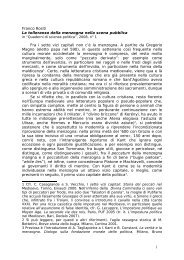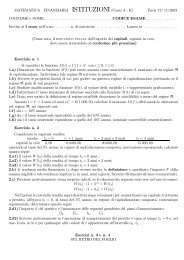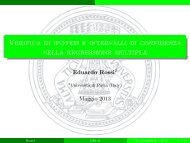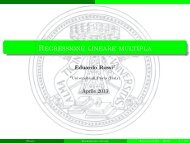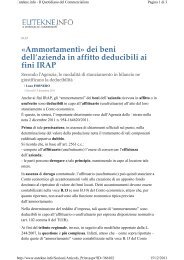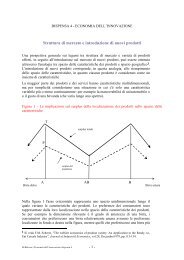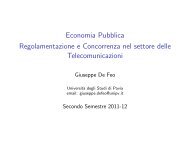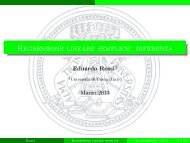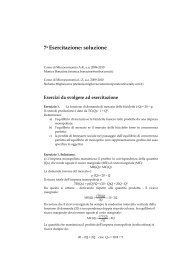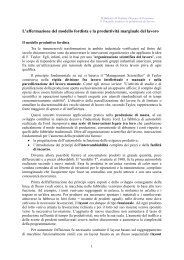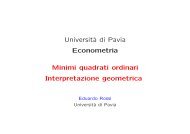International Incoming Student's Guide - Università degli studi di Pavia
International Incoming Student's Guide - Università degli studi di Pavia
International Incoming Student's Guide - Università degli studi di Pavia
Create successful ePaper yourself
Turn your PDF publications into a flip-book with our unique Google optimized e-Paper software.
<strong>International</strong> <strong>Incoming</strong> Student’s <strong>Guide</strong><br />
famous in the Christianity, quoted also by three major poets: Dante Alighieri, Petrarca<br />
and Boccaccio.<br />
A wonderful example of the Lombard gothic style is the majestic S.ta Maria del Carmine<br />
Church (XIV century), near Piazza Petrarca, hosting several art masterpieces. S. Francesco<br />
Grande (XIII century) is another gothic Church, situated near the University. San Lanfranco<br />
church, built during the same period, is a Romanesque buil<strong>di</strong>ng like S. Pietro in Verzolo<br />
(which has also baroque parts), and it is situated within a short <strong>di</strong>stance walk from the<br />
city centre. Close to Santa Maria del Carmine, S. Giovanni Domnarum (VII century) is one<br />
of the oldest churches in <strong>Pavia</strong>, built on a pre‐Romanesque structure (the only antique<br />
part is the crypt). The ancient frescoes of the crypt and the rose window of the XV<br />
century are worth a visit. Another old church is San Teodoro (XII century), situated in the<br />
antique “Roman” part of the town (between Piazza Vittoria, the old Roman foro and the<br />
river), with frescoes dating back to the Middle Age and the Renaissance.<br />
Among the religious buil<strong>di</strong>ngs, we can not forget the baroque style San Luca church (XVI‐<br />
XVII century), hosting a prestigious organ made in year 1835; Santa Maria <strong>di</strong> Canepanova,<br />
built near the Me<strong>di</strong>eval Towers; the Romanesque Santa Maria in Betlem (XII century), in<br />
the picturesque suburb of Borgo Ticino; the former San Felice monastry (VIII century),<br />
nowadays the centre of the Faculty of Economics, still preserving the old cloisters and the<br />
deconsecrated church (nowadays a study room) with wonderful frescoes. Last but not<br />
least, there is the Santi Gervasio e Protasio church that should be the first Church of <strong>Pavia</strong><br />
accor<strong>di</strong>ng to the tra<strong>di</strong>tion, established by bishop Siro (patron saint of <strong>Pavia</strong>) during the IV<br />
century.<br />
A few kilometres north from <strong>Pavia</strong>, we can find the famous Certosa <strong>di</strong> <strong>Pavia</strong>, founded by<br />
Gian Galeazzo Visconti in 1396. The Certosa is one of the most renowned monuments of<br />
Renaissance art in Italy. Work on the buil<strong>di</strong>ng that stands isolated on the plain<br />
surroun<strong>di</strong>ng <strong>Pavia</strong>, continued from the end of the 14th century until the mid‐16th<br />
century, together with the contemporary Cathedral of Milan. Construction began on the<br />
area reserved to the monks in the early 15th century, inclu<strong>di</strong>ng cells, a chapter house, a<br />
scriptorium, a <strong>di</strong>ning hall, and a vestry. The buil<strong>di</strong>ng was completed in 1542 and was also<br />
used as a “mausoleum” for the Visconti dynasty. There is also a larger cloister, containing<br />
small house‐like cells where the monks lived, worked and prayed in solitude; guest rooms<br />
(the so‐called “Duke’s Palace”, currently housing the Museum of the Chartreuse); the<br />
dormitory; a pharmacy; cellars, and storerooms for grains. The whole complex is<br />
surrounded by fields, lawns and vineyards, which were once attended to by the monks.<br />
Inside, the church hosts valuable paintings, sculptures and decorations such as the<br />
paintings and frescoes, the stained‐glass windows, the famous ivory polyptic, the marble<br />
tombs of Ludovico il Moro and Beatrice d’Este (Cristoforo Solari) and Gian Galeazzo Sforza<br />
(Gian Cristoforo Romano).<br />
10.3.2 Museums<br />
Musei Civici (Civic Museum)<br />
(in the Castello Visconteo).<br />
Piazza Castello<br />
University of <strong>Pavia</strong> – <strong>International</strong> Relations Division<br />
Corso Strada Nuova n. 65, 27100 <strong>Pavia</strong><br />
welcomepoint@unipv.it Tel +39 0382 984021 Fax +39 0382 984695<br />
49



